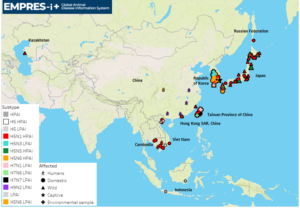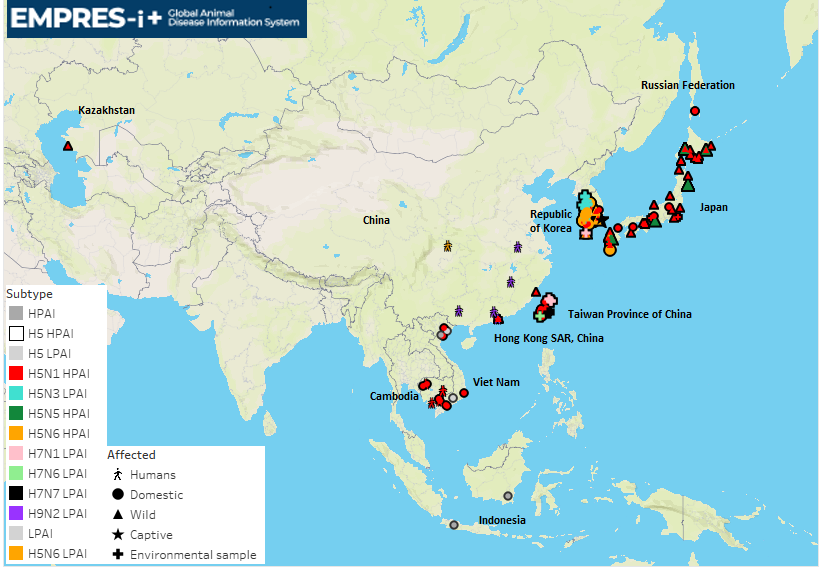The following article is based on a summary provided by Nick Lyons from the FAO Animal Production and Health division (NSAH). Minor revisions have been applied to the original article to improve clarity and align it with the guidelines established by the EAAFP.
FAO/EMPRES-AH is constantly monitoring the avian influenza situation worldwide and compiles information from multiple national and international sources as well as peer-reviewed scientific articles. In close collaboration with country and regional offices, the implementation of avian influenza field surveillance projects, and networks of expertise like WOAH/FAO’s OFFLU (www.offlu.org) provide access to timely information on outbreaks, surveillance findings, and genetic similarities of circulating viruses or their virological features. This information is stored in the EMPRES Global Animal Disease Information System (EMPRES-i), a database that can be accessed online at https://empres-i.apps.fao.org/.

©EMPRES-i
During the period from December 3, 2023, to March 8, 2024, three highly pathogenic avian influenza (HPAI) virus subtypes (H5N1, H5N5, and H5N6) and five low pathogenic avian influenza (LPAI) virus subtypes (H5N3, H7N1, H7N6, H7N7, and H7N9) have been reported in East and Southeast Asia. H5Nx HPAI viruses continue to circulate in Asia and are well established in certain areas of the region.
During this period, China reported H5N1 HPAI in in seven wild birds, including Eurasian Wigeon (Mareca penelope) in a national park in Fujian Province in December 2023. Taiwan Province confirmed H5N1 HPAI infection in Black-faced Spoonbill (Platalea minor) in December and January, and in Grey Heron (Ardea cinerea) in February. They also reported 28 outbreaks of H5N1 HPAI in chicken, duck and goose farms and detected two at a slaughterhouse. H7N1, H7N6, H7N7, and H7N9 LPAI were also confirmed in environmental samples (Anatidae feces). Hong Kong Special Administrative Region (SAR) detected H5N1 HPAI in environmental samples collected in early December, followed by confirmation in Eurasian Teal (Anas crecca), Eurasian Wigeon, Falcated Duck (Mareca falcata), and Pin-tailed Snipe (Gallinago stenura).
In the Republic of Korea, the major cause of HPAI outbreaks during this period was H5N6 HPAI virus, detected in 25 poultry outbreaks in four provinces affecting domestic chickens (15) and ducks (10), with more than two-thirds reported in North Jeolla Province. The virus was also reported in 12 samples from wild birds (mallard [Anas platyrhynchos], Mandarin Duck [Aix galericulata], Northern Shoveler [Spatula clypeata], Whooper Swan) and the environment from five provinces. In addition, H5N1 HPAI was reported in six farms (duck [4], chicken [2]) in three provinces, with one of these outbreaks being a mixed infection with H5N6. Eight samples were also reported from wild birds, including Eurasian Wigeon and Whooper Swan. The last AI event was on February 8th.
Moving further north, in Japan, the major cause of HPAI outbreaks during this period was H5N1 HPAI, with outbreaks reported on nine chicken farms; 71 events were also detected in sick/dead wild birds over 19 prefectures with 41 percent of these events reported from Hokkaido[1]. Fewer cases were reported among Hooded Crane (Grus monachal) (4) and White-naped Crane (Grus vipio) (3) at the Izumi Wintering Habitat of Cranes (a Ramsar Site), compared to the previous wintering season when more than 1,000 cranes died over the same period. This reduction may be due to some level of immunity developed in previously affected birds. Japan also reported 20 H5N5 HPAI detections in wild birds in Hokkaido and three other prefectures mostly in Large-billed Crow (Corvus macrorhynchos), and two H5N6 HPAI detections in a Peregrine Falcon and a chicken farm, both on Kyushu Island.
In the Russian Federation, one H5N1 outbreak was reported in domestic poultry in Sakhalin Oblast in February 2024, and to the west, Kazakhstan reported an H5N1 case in a Mute Swan (Cygnus olor) in December 2023 on Mangyshlak Peninsula by the Caspian Sea.
In Southeast Asia, Cambodia reported nine H5N1 HPAI outbreaks in village poultry in Battambang, Kandal, Kratié, Prey Veng and Siemreap provinces. Viet Nam confirmed H5N1 HPAI outbreaks in domestic birds in Bac Ninh, Long An, Ninh Binh, and Tien Giang provinces and HPAI (subtype unknown) in Khanh Hoa Province, between January 1st and February 23rd, 2024. Indonesia also confirmed HPAI outbreaks in January 2024 in West Java and South Kalimantan provinces. The Philippines and India reported H5N1 HPAI outbreaks in domestic birds that had occurred in early 2023.
In addition, China reported A(H5N6), A(H9N2) and A(H10N5) human infections in Sichuan (4) and Hong Kong SAR (1), with the case in the latter having recent travel history to Guangdong. Furthermore, Cambodia reported a total of five human infections with A(H5N1) virus during this period. Analysis showed that the two in Prey Veng and Siemreap provinces were caused by clade 2.3.2.1c of A(H5N1) virus, which is different from the H5N1 virus currently circulating worldwide (clade 2.3.4.4b). The results from the remining three A(H5N1) human cases in Kampot and Kratié provinces are pending.
Highly pathogenic H5N1, H5N2, H5N5, H5N6, and H5N8 viruses have demonstrated the ability to spread via migratory waterbirds. We consider avian influenza activity to be the highest in the period from December to March, therefore, reports of outbreaks in poultry or detections in wild birds are not expected to increase over the coming months in the region. However, recent confirmation of H5N1 in Cambodia and in the American side of Antarctica deserves closer attention and monitoring.
The list of bird species affected by H5Nx HPAI globally is available HERE with the new species reported since 2021 highlighted in orange.
[1] Species in which events were reported were: Carrion Crow [Corvus corone], crow [Corvus spp.], Dunlin [Calidris alpina), Eastern Buzzard [Buteo japonicas], Eurasian Wigeon, Hoodeed Crane [Grus monacha], Northern Goshawk [Accipiter gentilis], Peregrine Falcon [Falco peregrinus], Tufted Duck [Aythya fuligula], Ural Owl [Strix uralensis], White-naped Crane [Gris vipio], White-tailed Eagle [Haliaeetus albicilla] and Whooper Swan [Cygnus Cygnus].





